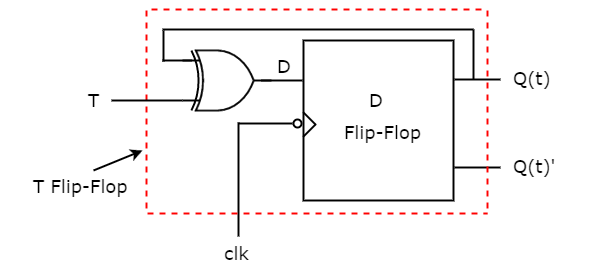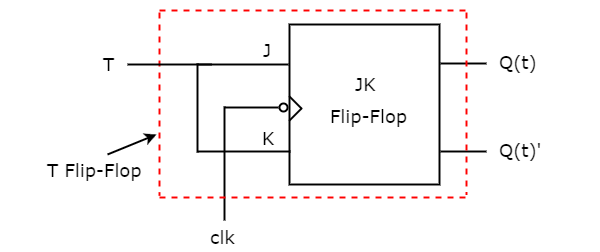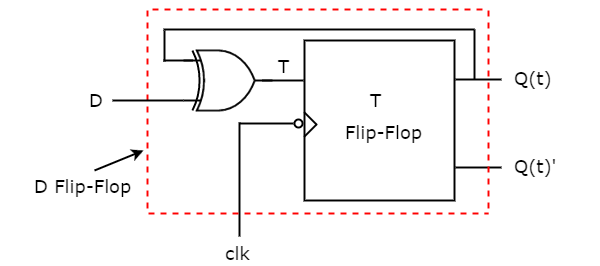Digital Circuits - Conversion of Flip-Flops
Digital Circuits - Conversion of Flip-Flops
In previous chapter, we discussed the four flip-flops, namely SR flip-flop, D flip-flop, JK flip-flop & T flip-flop. We can convert one flip-flop into the remaining three flip-flops by including some additional logic. So, there will be total of twelve flip-flop conversions.
Follow these steps for converting one flip-flop to the other.
-
Consider the characteristic table of desired flip-flop.
-
Fill the excitation values inputs?????? of given flip-flop for each combination of present state and next state. The excitation table for all flip-flops is shown below.
| Present State | Next State | SR flip-flop inputs | D flip-flop input | JK flip-flop inputs | T flip-flop input | ||
|---|---|---|---|---|---|---|---|
| Qt? | Qt+1?+1 | S | R | D | J | K | T |
| 0 | 0 | 0 | x | 0 | 0 | x | 0 |
| 0 | 1 | 1 | 0 | 1 | 1 | x | 1 |
| 1 | 0 | 0 | 1 | 0 | x | 1 | 1 |
| 1 | 1 | x | 0 | 1 | x | 0 | 0 |
-
Get the simplified expressions for each excitation input. If necessary, use Kmaps for simplifying.
-
Draw the circuit diagram of desired flip-flop according to the simplified expressions using given flip-flop and necessary logic gates.
Now, let us convert few flip-flops into other. Follow the same process for remaining flipflop conversions.
SR Flip-Flop to other Flip-Flop Conversions
Following are the three possible conversions of SR flip-flop to other flip-flops.
- SR flip-flop to D flip-flop
- SR flip-flop to JK flip-flop
- SR flip-flop to T flip-flop
SR flip-flop to D flip-flop conversion
Here, the given flip-flop is SR flip-flop and the desired flip-flop is D flip-flop. Therefore, consider the following characteristic table of D flip-flop.
| D flip-flop input | Present State | Next State |
|---|---|---|
| D | Qt? | Qt+1?+1 |
| 0 | 0 | 0 |
| 0 | 1 | 0 |
| 1 | 0 | 1 |
| 1 | 1 | 1 |
We know that SR flip-flop has two inputs S & R. So, write down the excitation values of SR flip-flop for each combination of present state and next state values. The following table shows the characteristic table of D flip-flop along with the excitation inputs of SR flip-flop.
| D flip-flop input | Present State | Next State | SR flip-flop inputs | |
|---|---|---|---|---|
| D | Qt? | Qt+1?+1 | S | R |
| 0 | 0 | 0 | 0 | x |
| 0 | 1 | 0 | 0 | 1 |
| 1 | 0 | 1 | 1 | 0 |
| 1 | 1 | 1 | x | 0 |
From the above table, we can write the Boolean functions for each input as below.
S=m2+d3?=?2+?3
R=m1+d0?=?1+?0
We can use 2 variable K-Maps for getting simplified expressions for these inputs. The k-Maps for S & R are shown below.

So, we got S = D & R = D' after simplifying. The circuit diagram of D flip-flop is shown in the following figure.

This circuit consists of SR flip-flop and an inverter. This inverter produces an output, which is complement of input, D. So, the overall circuit has single input, D and two outputs Qt? & Qt?'. Hence, it is a D flip-flop. Similarly, you can do other two conversions.
D Flip-Flop to other Flip-Flop Conversions
Following are the three possible conversions of D flip-flop to other flip-flops.
- D flip-flop to T flip-flop
- D flip-flop to SR flip-flop
- D flip-flop to JK flip-flop
D flip-flop to T flip-flop conversion
Here, the given flip-flop is D flip-flop and the desired flip-flop is T flip-flop. Therefore, consider the following characteristic table of T flip-flop.
| T flip-flop input | Present State | Next State |
|---|---|---|
| T | Qt? | Qt+1?+1 |
| 0 | 0 | 0 |
| 0 | 1 | 1 |
| 1 | 0 | 1 |
| 1 | 1 | 0 |
We know that D flip-flop has single input D. So, write down the excitation values of D flip-flop for each combination of present state and next state values. The following table shows the characteristic table of T flip-flop along with the excitation input of D flip-flop.
| T flip-flop input | Present State | Next State | D flip-flop input |
|---|---|---|---|
| T | Qt? | Qt+1?+1 | D |
| 0 | 0 | 0 | 0 |
| 0 | 1 | 1 | 1 |
| 1 | 0 | 1 | 1 |
| 1 | 1 | 0 | 0 |
From the above table, we can directly write the Boolean function of D as below.
D=T⊕Q(t)?=?⊕?(?)
So, we require a two input Exclusive-OR gate along with D flip-flop. The circuit diagram of T flip-flop is shown in the following figure.

This circuit consists of D flip-flop and an Exclusive-OR gate. This Exclusive-OR gate produces an output, which is Ex-OR of T and Qt?. So, the overall circuit has single input, T and two outputs Qt? & Qt?’. Hence, it is a T flip-flop. Similarly, you can do other two conversions.
JK Flip-Flop to other Flip-Flop Conversions
Following are the three possible conversions of JK flip-flop to other flip-flops.
- JK flip-flop to T flip-flop
- JK flip-flop to D flip-flop
- JK flip-flop to SR flip-flop
JK flip-flop to T flip-flop conversion
Here, the given flip-flop is JK flip-flop and the desired flip-flop is T flip-flop. Therefore, consider the following characteristic table of T flip-flop.
| T flip-flop input | Present State | Next State |
|---|---|---|
| T | Qt? | Qt+1?+1 |
| 0 | 0 | 0 |
| 0 | 1 | 1 |
| 1 | 0 | 1 |
| 1 | 1 | 0 |
We know that JK flip-flop has two inputs J & K. So, write down the excitation values of JK flip-flop for each combination of present state and next state values. The following table shows the characteristic table of T flip-flop along with the excitation inputs of JK flipflop.
| T flip-flop input | Present State | Next State | JK flip-flop inputs | |
|---|---|---|---|---|
| T | Qt? | Qt+1?+1 | J | K |
| 0 | 0 | 0 | 0 | x |
| 0 | 1 | 1 | x | 0 |
| 1 | 0 | 1 | 1 | x |
| 1 | 1 | 0 | x | 1 |
From the above table, we can write the Boolean functions for each input as below.
J=m2+d1+d3?=?2+?1+?3
K=m3+d0+d2?=?3+?0+?2
We can use 2 variable K-Maps for getting simplified expressions for these two inputs. The k-Maps for J & K are shown below.

So, we got, J = T & K = T after simplifying. The circuit diagram of T flip-flop is shown in the following figure.

This circuit consists of JK flip-flop only. It doesn’t require any other gates. Just connect the same input T to both J & K. So, the overall circuit has single input, T and two outputs Qt? & Qt?’. Hence, it is a T flip-flop. Similarly, you can do other two conversions.
T Flip-Flop to other Flip-Flop Conversions
Following are the three possible conversions of T flip-flop to other flip-flops.
- T flip-flop to D flip-flop
- T flip-flop to SR flip-flop
- T flip-flop to JK flip-flop
T flip-flop to D flip-flop conversion
Here, the given flip-flop is T flip-flop and the desired flip-flop is D flip-flop. Therefore, consider the characteristic table of D flip-flop and write down the excitation values of T flip-flop for each combination of present state and next state values. The following table shows the characteristic table of D flip-flop along with the excitation input of T flip-flop.
| D flip-flop input | Present State | Next State | T flip-flop input | |
|---|---|---|---|---|
| D | Qt? | Qt+1?+1 | T | |
| 0 | 0 | 0 | 0 | |
| 0 | 1 | 0 | 1 | |
| 1 | 0 | 1 | 1 | |
| 1 | 1 | 1 | 0 | |
From the above table, we can directly write the Boolean function of T as below.
T=D⊕Q(t)?=?⊕?(?)
So, we require a two input Exclusive-OR gate along with T flip-flop. The circuit diagram of D flip-flop is shown in the following figure.

This circuit consists of T flip-flop and an Exclusive-OR gate. This Exclusive-OR gate produces an output, which is Ex-OR of D and Qt?. So, the overall circuit has single input, D and two outputs Qt? & Qt?’. Hence, it is a D flip-flop. Similarly, you can do other two conversions.
Frequently Asked Questions
Recommended Posts:
- Digital Circuits Tutorial
- Digital Circuits - Number Systems
- Digital Circuits - Signed Binary Arithmetic
- Digital Circuits - Codes
- Error Detection & Correction Codes
- Digital Circuits - Boolean Algebra
- Digital Circuits - Canonical & Standard Forms
- Digital Circuits - K-Map Method
- Quine-McCluskey Tabular Method
- Digital Circuits - Logic Gates
- Digital Circuits - Two-Level Logic Realization
- Digital Combinational Circuits
- Digital Circuits - Decoders
- Digital Circuits - Encoders
- Digital Circuits - Encoders
